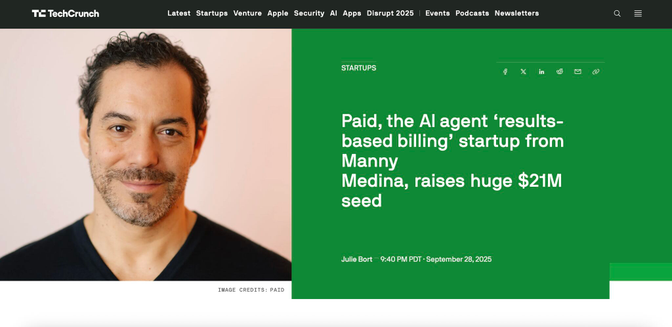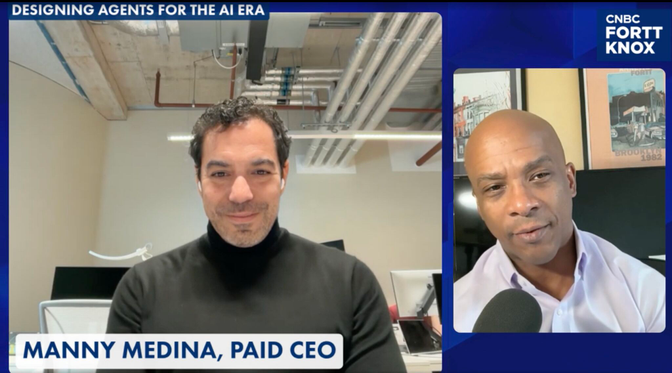Insights straight to your inbox
Join 10,000+ subscribers getting the latest insights on AI monetization.


This week we announced our $21M Series Seed led by Lightspeed Venture Partners, with participation from FUSE and existing investor EQT Ventures (meaning total funding now stands at $33.3 million).
It's been a few days now. The news has settled. I wanted to take a moment to reflect on what happened and what it means.
Monday morning, Julie Bort broke the news in TechCrunch, followed by Manny talking on Bloomberg's Daybreak with Tom Mackenzie.


In the evening, we announced Paid's seed round ourselves on this blog!
Tuesday brought a longer conversation with Jon Fortt on Fortt Knox.

Jon pushed on the hard questions. How do you price agents when the per-seat model is dead? What happens when agents operate in the background? How do you prevent rogue agents from burning through budgets? What's the cost structure when LLM tokens are expensive?
They're real issues companies are facing right now as they deploy agents. And honestly, hearing them articulated by someone outside our bubble confirmed what we've been seeing: this is a genuine problem that needs solving.
Seeing Paid on the Nasdaq tower in Times Square was surreal. You work on something for months in a small office in London, and suddenly it's 50 feet tall in the middle of Manhattan.

Jon Fortt asked Manny the questions we've been wrestling with internally for months. How do you price agents when they operate in the background? What happens when LLM costs spike unexpectedly? How do you prevent rogue agents from burning through budgets?
These questions is what happens when you try to monetize something that doesn't behave like traditional software.
Hearing them articulated by someone outside our world confirmed something important: we're not solving edge cases. We're solving the core problem that every company deploying agents will eventually hit.
The pattern recognition feels right. The timing feels right. The problem is real and getting more urgent.
I've been through funding announcements before. They usually follow a script. Big number, impressive investors, bold vision for the future, the usual stuff
I may be biased, but this one feels different to me. Not because of the amount or the logos, but because of what's happening in the market right now.
SaaS companies are stuck. Growth has flatlined. Seat-based pricing is breaking because AI agents are replacing the seats. The business model that built a trillion-dollar industry doesn't work when your product eliminates headcount instead of enabling it.
We're watching companies struggle with this in real time. They know they need to pivot to agents. They don't know how to monetize them profitably.
That's not a future problem. That's happening right now. And the infrastructure to solve it doesn't exist yet.
That's what makes this moment interesting. We're not building for what might happen in five years. We're building for what's breaking today.
The thesis is straightforward: 50% of the workforce will be agents by 2030. The seat-based pricing model is already breaking. Companies need new infrastructure to monetize agents, track costs, and prove ROI.
That's what Paid does. Cost tracking that shows you what each agent actually costs to run. Billing that handles outcome-based and hybrid pricing models. Margin management so you know if you're making money. ROI reporting so your customers can see the value.
We started by proving this works for agent-first companies. Now we're helping SaaS companies make the transition before their competitors do.
The announcement week is over. Now comes the part that actually matters.
We've got the resources and team to build what the AI agent economy needs. But infrastructure is only valuable if it solves real problems for real people.
That's what we're focused on now. Not the headlines or the funding amount. Just making sure what we build actually works.
The conversations we had last week with founders making this transition were more valuable than any press hit. They're wrestling with pricing models that don't fit their products. They're watching costs spiral without visibility into what's driving them. They're trying to prove ROI to customers when agent work is invisible.
Those are the problems worth solving. Those are the conversations worth having.
If you're making the transition to agents and need to figure out the economics, let's talk.
Join 10,000+ subscribers getting the latest insights on AI monetization.



Price smarter. Protect margins. Grow revenue.